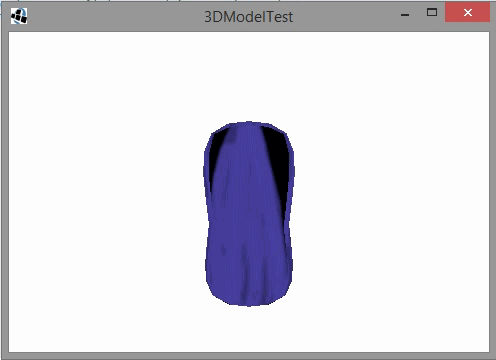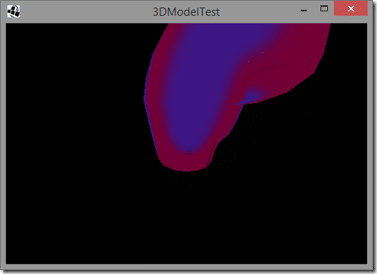Back in this post I discussed ways of making dynamically equipped 2D sprites. One way was to render out a 3D object to 2D textures dynamically. So far we have looked at working in 3D in LibGDX, then exporting and rendering an animated model from Blender, the next step would be a dynamic 3D object to texture. At first glance I thought this would be difficult, but reality is, it was stupidly simple. In fact, the very first bit of code I wrote simply worked! Well, except the results being upside down I suppose… details details…
Anyways, that is what this post discusses. Taking a 3D scene in LibGDX and rendering in a 2D texture. The code is just a modification of the code from the Blender to GDX post from a couple days back.
package com.gamefromscratch; import com.badlogic.gdx.ApplicationListener; import com.badlogic.gdx.Files.FileType; import com.badlogic.gdx.Gdx; import com.badlogic.gdx.InputProcessor; import com.badlogic.gdx.graphics.GL10; import com.badlogic.gdx.graphics.PerspectiveCamera; import com.badlogic.gdx.graphics.Pixmap.Format; import com.badlogic.gdx.graphics.Texture; import com.badlogic.gdx.graphics.g2d.SpriteBatch; import com.badlogic.gdx.graphics.g2d.TextureRegion; import com.badlogic.gdx.graphics.g3d.Environment; import com.badlogic.gdx.graphics.g3d.Model; import com.badlogic.gdx.graphics.g3d.ModelBatch; import com.badlogic.gdx.graphics.g3d.ModelInstance; import com.badlogic.gdx.graphics.g3d.attributes.ColorAttribute; import com.badlogic.gdx.graphics.g3d.loader.G3dModelLoader; import com.badlogic.gdx.utils.UBJsonReader; import com.badlogic.gdx.graphics.g3d.utils.AnimationController; import com.badlogic.gdx.graphics.g3d.utils.AnimationController.AnimationDesc; import com.badlogic.gdx.graphics.g3d.utils.AnimationController.AnimationListener; import com.badlogic.gdx.graphics.glutils.FrameBuffer; public class ModelTest implements ApplicationListener, InputProcessor { private PerspectiveCamera camera; private ModelBatch modelBatch; private Model model; private ModelInstance modelInstance; private Environment environment; private AnimationController controller; private boolean screenShot = false; private FrameBuffer frameBuffer; private Texture texture = null; private TextureRegion textureRegion; private SpriteBatch spriteBatch; @Override public void create() { // Create camera sized to screens width/height with Field of View of 75 degrees camera = new PerspectiveCamera( 75, Gdx.graphics.getWidth(), Gdx.graphics.getHeight()); // Move the camera 5 units back along the z-axis and look at the origin camera.position.set(0f,0f,7f); camera.lookAt(0f,0f,0f); // Near and Far (plane) represent the minimum and maximum ranges of the camera in, um, units camera.near = 0.1f; camera.far = 300.0f; // A ModelBatch is like a SpriteBatch, just for models. Use it to batch up geometry for OpenGL modelBatch = new ModelBatch(); // Model loader needs a binary json reader to decode UBJsonReader jsonReader = new UBJsonReader(); // Create a model loader passing in our json reader G3dModelLoader modelLoader = new G3dModelLoader(jsonReader); // Now load the model by name // Note, the model (g3db file ) and textures need to be added to the assets folder of the Android proj model = modelLoader.loadModel(Gdx.files.getFileHandle("data/benddemo.g3db", FileType.Internal)); // Now create an instance. Instance holds the positioning data, etc of an instance of your model modelInstance = new ModelInstance(model); //move the model down a bit on the screen ( in a z-up world, down is -z ). modelInstance.transform.translate(0, 0, -2); // Finally we want some light, or we wont see our color. The environment gets passed in during // the rendering process. Create one, then create an Ambient ( non-positioned, non-directional ) light. environment = new Environment(); environment.set(new ColorAttribute(ColorAttribute.AmbientLight, 0.8f, 0.8f, 0.8f, 1.0f)); // You use an AnimationController to um, control animations. Each control is tied to the model instance controller = new AnimationController(modelInstance); // Pick the current animation by name controller.setAnimation("Bend",1, new AnimationListener(){ @Override public void onEnd(AnimationDesc animation) { // this will be called when the current animation is done. // queue up another animation called "balloon". // Passing a negative to loop count loops forever. 1f for speed is normal speed. controller.queue("Balloon",-1,1f,null,0f); } @Override public void onLoop(AnimationDesc animation) { // TODO Auto-generated method stub } }); frameBuffer = new FrameBuffer(Format.RGB888,Gdx.graphics.getWidth(),Gdx.graphics.getHeight(),false); Gdx.input.setInputProcessor(this); spriteBatch = new SpriteBatch(); } @Override public void dispose() { modelBatch.dispose(); model.dispose(); } @Override public void render() { // You've seen all this before, just be sure to clear the GL_DEPTH_BUFFER_BIT when working in 3D Gdx.gl.glViewport(0, 0, Gdx.graphics.getWidth(), Gdx.graphics.getHeight()); Gdx.gl.glClearColor(1, 1, 1, 1); Gdx.gl.glClear(GL10.GL_COLOR_BUFFER_BIT | GL10.GL_DEPTH_BUFFER_BIT); // When you change the camera details, you need to call update(); // Also note, you need to call update() at least once. camera.update(); // You need to call update on the animation controller so it will advance the animation. Pass in frame delta controller.update(Gdx.graphics.getDeltaTime()); // If the user requested a screenshot, we need to call begin on our framebuffer // This redirects output to the framebuffer instead of the screen. if(screenShot) frameBuffer.begin(); // Like spriteBatch, just with models! pass in the box Instance and the environment modelBatch.begin(camera); modelBatch.render(modelInstance, environment); modelBatch.end(); // Now tell OpenGL that we are done sending graphics to the framebuffer if(screenShot) { frameBuffer.end(); // get the graphics rendered to the framebuffer as a texture texture = frameBuffer.getColorBufferTexture(); // welcome to the wonderful world of different coordinate systems! // simply put, the framebuffer is upside down to normal textures, so we have to flip it // Use a TextureRegion to do so textureRegion = new TextureRegion(texture); // and.... FLIP! V (vertical) only textureRegion.flip(false, true); } // In the case that we have a texture object to actually draw, we do so // using the old familiar SpriteBatch to do so. if(texture != null) { spriteBatch.begin(); spriteBatch.draw(textureRegion,0,0); spriteBatch.end(); screenShot = false; } } @Override public void resize(int width, int height) { } @Override public void pause() { } @Override public void resume() { } @Override public boolean keyDown(int keycode) { // TODO Auto-generated method stub return false; } @Override public boolean keyUp(int keycode) { // TODO Auto-generated method stub return false; } @Override public boolean keyTyped(char character) { // If the user hits a key, take a screen shot. this.screenShot = true; return false; } @Override public boolean touchDown(int screenX, int screenY, int pointer, int button) { // TODO Auto-generated method stub return false; } @Override public boolean touchUp(int screenX, int screenY, int pointer, int button) { // TODO Auto-generated method stub return false; } @Override public boolean touchDragged(int screenX, int screenY, int pointer) { // TODO Auto-generated method stub return false; } @Override public boolean mouseMoved(int screenX, int screenY) { // TODO Auto-generated method stub return false; } @Override public boolean scrolled(int amount) { // TODO Auto-generated method stub return false; } }
And… that’s it.
Run the code and you get the exact same results as the last example:
However, if you press any key, the current frame is saved to a texture, and that is instead displayed on screen. Press a key again and it will update to the current frame:
Of course, the background colour is different, because we didn’t implicitly set one. The above a is LibGDX Texture object, which can now be treated as a 2D sprite, used as a texture map, whatever.
The code is ultra simple. We have a toggle variable screenShot, that gets set if a user hits a key. The actual process of rendering to texture is done with the magic of FrameBuffersl Think of a framebuffer as a place for OpenGL to render other than your video card. So instead of drawing the graphics to the screen, it instead draws the graphics to a memory buffer. We then get this memory buffer as a texture using getColorBufferTexture(). The only complication is the frame buffer is rendered upside down. This is easily fixed by wrapping the Texture in a TextureRegion and flipping the V coordinate. Finally we display our newly generated texture using our old friend, the SpriteBatch.
Gotta love it when something you expect to be difficult ends up being ultra easy. Next I have to measure the performance, so see if this is something that can be done in a realtime situation, or do we need to do this onload/change?


